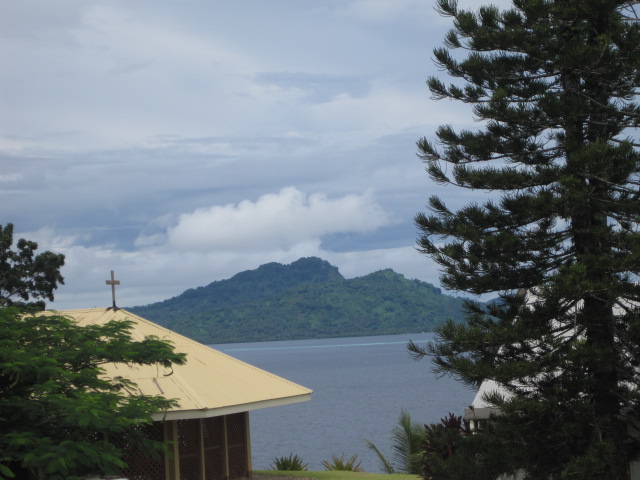There is always a little bit of heaven in a disaster area.–Wavy Gravy
A storm was blowing through Weno last Saturday–rain slamming down; winds whipping across the water. But 100 feet below the surface of the water, all was calm and still and a rich blue. I explored the remains of two Japanese supply ships, the Rio de Janeiro Maru and the Sankisan Maru Each one was carrying munitions–torpedoes, bombs, explosives, bullets when it went down. They were left foundering  and ablaze in the lagoon when Operation Hailstone was complete, and the U.S. planes stopped their attack. As each one burned, the flames reached the munitions and the explosions inside the ships brought them down.
and ablaze in the lagoon when Operation Hailstone was complete, and the U.S. planes stopped their attack. As each one burned, the flames reached the munitions and the explosions inside the ships brought them down.
The Sankisan, sits upright on the ocean floor. I swam along the decks, all covered in coral and teeming with fish– batfish the size of a laptop; yellow and black angels, their fins trailing behind them like streamers; a barracuda ominous and still, staring down at me as I passed beneath.
Toward the stern the discernable shapes and landmarks of the ship gave way to twisted metal from the explosions that blew out the back of the vessel sinking her. Utter destruction–nothing here was recognizable. It was as if the  ship was dipped into some sort of shredder and pulled out. We swam into a hold from here. The light and color from earlier faded quickly into a thick, murky darkness. Once inside, we needed flashlights to see clearly. It was tight and claustrophobic. Torpedoes, rusted trucks, Japanese Zero plane parts seemed to float out of the gloom as we swam toward them. The deeper into the wreck we went, the more the weight of the scene pressed in on us. The floor below was littered with bottles and medicine jars. A truck engine block appeared–then a machine gun. But perhaps the image that will always stick with me was the bullets. Hundreds, maybe thousands, of them–everywhere. In clips, in boxes, and in piles on the floor. Everywhere.
ship was dipped into some sort of shredder and pulled out. We swam into a hold from here. The light and color from earlier faded quickly into a thick, murky darkness. Once inside, we needed flashlights to see clearly. It was tight and claustrophobic. Torpedoes, rusted trucks, Japanese Zero plane parts seemed to float out of the gloom as we swam toward them. The deeper into the wreck we went, the more the weight of the scene pressed in on us. The floor below was littered with bottles and medicine jars. A truck engine block appeared–then a machine gun. But perhaps the image that will always stick with me was the bullets. Hundreds, maybe thousands, of them–everywhere. In clips, in boxes, and in piles on the floor. Everywhere.
Ambient light from a hold opening signaled the way out. Emerging to the ship’s deck, a whole different world came into focus. Colors, more vibrant than before, held my gaze. I just wanted to drink in all the shades of reds,  blues, yellows, oranges, purples, and greens. Every fish darting by turned my head. A clownfish scurried around an enormous anemone. A clam as big as a basketball smiled from coral on the ship’s mast. It was so….alive. Yeah, that’s it. Alive, and growing–thriving.
blues, yellows, oranges, purples, and greens. Every fish darting by turned my head. A clownfish scurried around an enormous anemone. A clam as big as a basketball smiled from coral on the ship’s mast. It was so….alive. Yeah, that’s it. Alive, and growing–thriving.
I kept flashing on a soundbite slogan from a bumper sticker I’ve seen dozens of times–Nature Bats Last. Coming out from the ship’s hold, filled with dying relics, the stuff of war, the stuff or destruction, the stuff of hate and death, I saw all the life around me with new eyes. The sea was reclaiming this one-time weapon and decorating it with Life. I was exploring the scene of a furious battle, and, fifty years later, you know who won? Beauty. Nature. Life.
Later, when I was back at school, Ruffina asked me if I was going to ride into town with her and some of the others on campus to go to mass. I told her I wasn’t. I didn’t need to go to church today. It would be redundant. “I already talked with God today under the water.”
“Oh really?” she chortled, “What did he say?”
“He said, ‘It’s going to be okay.’ ”
Special thanks to Angelo from Saipan for sharing his pictures from the dive.













Chris – a nice read. bravo and well done. I got to swim around a coral reef for a few minutes there. much obliged.
Those underwater photos are outstanding.